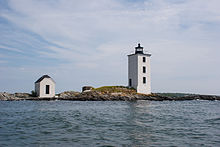Dutch Island Light

Dutch Island light in 2009, viewed from a kayak
|
|
| Location | Jamestown, Rhode Island |
|---|---|
| Coordinates | 41°29′48.27″N 71°24′15.35″W / 41.4967417°N 71.4042639°WCoordinates: 41°29′48.27″N 71°24′15.35″W / 41.4967417°N 71.4042639°W |
| Year first constructed | 1826 |
| Year first lit | 1857 |
| Automated | 1947 |
| Deactivated | 1979 - 2007 |
| Foundation | Surface rock |
| Construction | Brick |
| Tower shape | Square |
| Markings / pattern | White with black lantern |
| Focal height | 56 feet (17 m) |
| Original lens | 4th order Fresnel lens |
| Current lens | 9.8 inches (250 mm) |
| Characteristic | Flashing red 6 seconds |
| Fog signal | none |
| Admiralty number | J0621 |
| ARLHS number | USA-250 |
| USCG number |
1-19101 |
|
Dutch Island Lighthouse
|
|
 |
|
| Built | 1857 |
| MPS | Lighthouses of Rhode Island TR |
| NRHP Reference # | 87001701 |
| Added to NRHP | February 25, 1988 |
1-19101
Dutch Island Light is an historic lighthouse on Dutch Island off Jamestown, Rhode Island.
In 1825 the federal government acquired 6 acres (2.4 ha) at the southern end of the island, and on January 1, 1827, Dutch Island Light was established to mark the west passage of Narragansett Bay and to aid vessels entering Dutch Island Harbor. The first 30-foot (9.1 m) tower was built of stones found on the island. The government constructed a new 42-foot (13 m) brick tower in 1857 with a fog bell added in 1878.
Dutch Island is located in the West Passage of Narragansett Bay between Jamestown and Saunderstown, Rhode Island. Originally it was called "Quetenis" by the Narragansett people, who sold it to the Dutch West India Company about 1636. The Dutch from New Amsterdam (later New York) used the island as a safe place to trade their goods to the Narragansett for meat, fish and furs. Later the English settlers of Rhode Island used the island to graze sheep.
For many years it was fortified to protect the West Passage from sea invasion. It is not known whether this included the Revolutionary War era when the Conanicut Battery was activated further south on the western shore of Conanicut (Jamestown) Island. Dutch Island was later heavily fortified with massive concrete gun emplacements. These were started with large granite store structures near the southern end of the island during the Civil War. In the late 19th century there was a battery of 15-inch (380 mm) Rodman guns (25-ton cannon which used a 50-pound charge of black powder to fire a 300-pound cannonball as far as 3 miles (4.8 km)) on the point at the southern end of the island.
In the late 1890s the Army established Fort Greble on Dutch Island. Fort Greble was an Endicott-era coastal fortification which featured long-range rifled artillery pieces and could house as many as 495 officers and men. Fort Greble was an active post until 1924 and was used for National Guard training up to World War II.
In 1825, the U.S. government bought 6 acres (24,000 m2) on the southern tip of the island with the purpose of establishing a "light station". The first tower was built in 1826 using native stone from the island. It was 30 feet (9.1 m) tall. One of the first keepers was Robert Dennis, whose father had fought in the Revolution and who was also present at the Boston Tea Party. Dennis was 78 years old when he became keeper and apparently remained keeper until he was well into his nineties. His son, Robert, took his position when his father died.
...
Wikipedia

